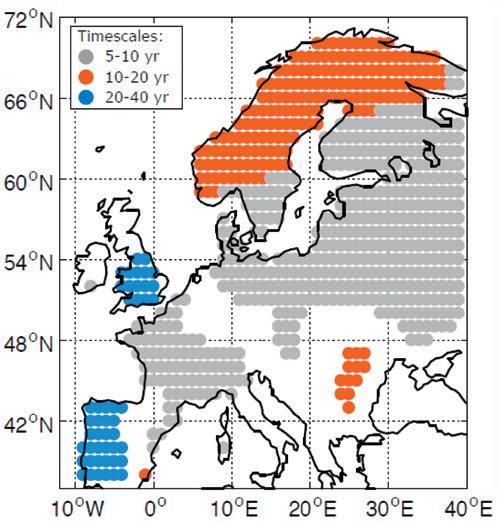
4 minute read
Summary
Globally, the importance of managing the oceans in a more sustainable manner has been widely recognised in the United Nations Sustainable Development Goals (UN SDGs), the UN Decade of Ocean Science for Sustainable Development and elsewhere. In Europe the increased recognition of the importance of our oceans and seas is seen in the Blue Economy and in the Green Deal initiatives. However, such policies have to be set against the background that the historical state of flux in our oceans and seas is changing owing to global warming. This report focuses on the Europe’s future in the Atlantic realm and thus the Atlantic Ocean and the seas along Europe’s western coasts (excluding the Mediterranean and Black Seas).
The report describes the underlying processes and trends in the Atlantic, and the ways in which the state of the ocean – currents, winds, waves and ocean mixing – impact Europe’s climate, marine environment and resources. A dominant influence is the global thermohaline circulation which includes the Atlantic Ocean currents that transport heat and salt into northern latitudes via the Gulf Stream and North Atlantic Drift, with colder and denser waters returning south at depth; this is the Atlantic Meridional Overturning Circulation (AMOC). Superimposed on this are patterns of variability in both the atmosphere (the North Atlantic Oscillation) and the ocean (the Atlantic Multidecadal Variability). Palaeoclimatic records show that changes in these basic processes may have substantial local and global effects on climate and on marine and coastal ecosystems.
Advertisement
Against the background of natural variability, direct impacts of global climate change can be seen in the sea surface temperature which has increased by nearly 1 °C since the 1890s, in sea level which has risen by 11–16 cm during the 20th century; and in seawater pH which has decreased by about 0.1 pH units since the start of the Industrial Revolution. Climate change may also be affecting the complex oceanic processes underpinning the goods and benefits we receive from marine ecosystems.
In this report, these processes and their importance for European Union (EU) marine policies are reviewed in detail together with the results of recent research. One policy example is the ‘Blue Economy’ which aims to increase the economic contribution from the oceans as part of an integrated marine policy. The Marine Strategy Framework Directive, adopted in 2008, addresses the environmental aspects. Most recently, protecting our seas and oceans is an integral objective of the European Green Deal and part of the Biodiversity Strategy for 2030. Key issues identified in this report are as follows. The AMOC and the Gulf Stream. The transfer of heat from the subtropics to the Arctic Ocean is critical for Europe’s climate. While several studies suggest that the AMOC has weakened in recent decades (upper estimates are 15–30%), this is not yet confirmed as a trend by several indicators described in detail in the report; nor has a similar weakening been observed in the Gulf Stream per se. Neither is it yet clear how to distinguish any trends from underlying interannual to decadal variability. Nevertheless, a weakening of around 20% in the AMOC is expected by the end of this century, and collapse remains a possibility in the longer term beyond 2100. Uncertainties remain in how the accelerated melting of the Greenland ice cap influences the AMOC as well as surface water salinity, and recent research has also emphasised the extent to which the AMOC affects climate as far as Asia and Africa while buffering the surface warming for the planet as a whole. The trends in the AMOC are thus not just a European issue, and monitoring and research to improve our understanding is important with the ultimate objective of providing an early warning for trends towards weakening or even collapse.
Of more immediate practical and societal impact are the effects of short-term fluctuations in European climaterelated conditions that are the result of variations in ocean circulation (including variability of the Gulf Stream and its branches towards Europe), and their interaction with the atmosphere. There is evidence that the relatively slow changes in ocean circulation that affect the atmosphere and Europe downwind allow a degree of predictability with a forecast horizon of seasons to years into the future. Substantiating this predictability offers potential benefits for societal and commercial planning purposes and preparedness, and should be developed to allow application in a range of fields including tourism, renewable energy production, agriculture, aquaculture and fisheries.
Sea level rise. Rising sea levels increase the risk of future high-impact storm surges, waves and high tides. Under high emission pathways, the 5 million Europeans currently at risk of seawater flooding once every 100 years may be flooded almost annually by 2100. Planning for future sea level rise (SLR) along the European coast has to recognise two major sources of uncertainty. The first is the average global SLR derived mainly from the melting of the Antarctic and Greenland ice sheets. A second source of uncertainty arises from the local variations in geography and susceptibility to Atlantic circulation and associated weather patterns.
Substantial assets and populations will be at risk if insufficient SLR is factored into erosion control planning and adaptation for population centres along coasts





